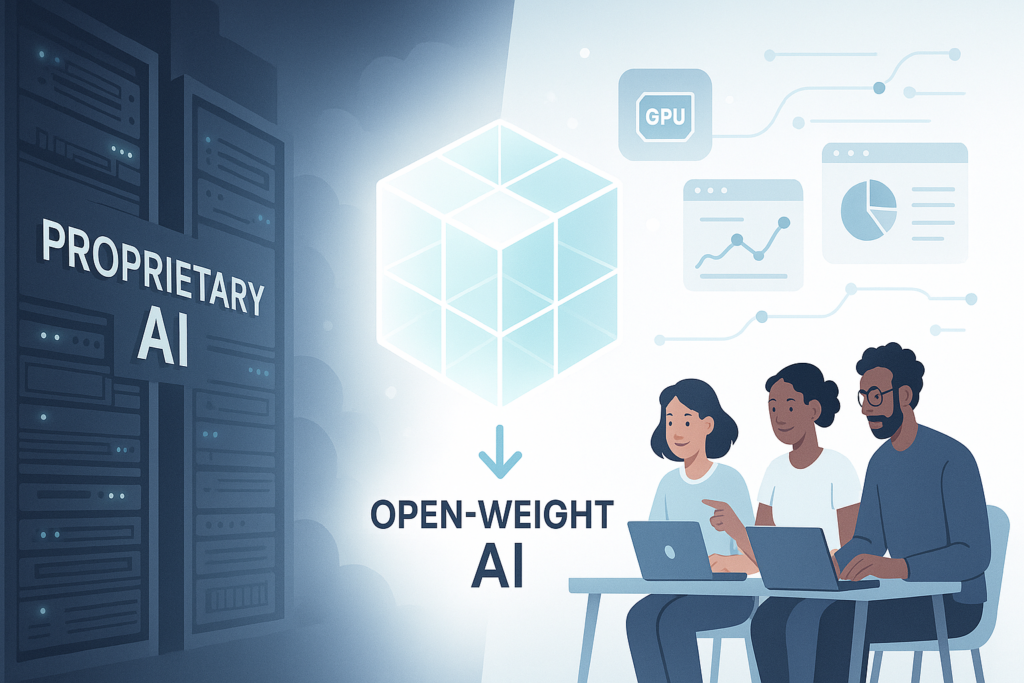Table of Content
AI has long been associated with high infrastructure costs, limiting access to advanced capabilities. Open-weight AI models are transforming this by lowering costs, enabling customization, and giving businesses greater control over AI deployment.
Unlike proprietary AI models that demand extensive computing power, open-weight models let companies train, fine-tune, and deploy AI with lower infrastructure costs. This shift makes AI more accessible and scalable across industries.
By leveraging open-weight models, companies can significantly accelerate AI development—enabling faster prototyping cycles, smoother integration with internal systems, and reduced time to market for AI-powered products.
A key example of this shift is DeepSeek-R1[1], which has significantly lowered inference token costs when self-hosted—demonstrating that high-performance AI no longer requires billion-dollar investments. Developers can now build AI chatbots, AI-powered assistants, automation tools, and other intelligent applications without relying solely on proprietary AI ecosystems.
Additionally, many open-weight models can be optimized—through techniques like quantization or distillation—to run on less-powerful GPUs, further reducing infrastructure costs and expanding AI accessibility. As a result, businesses can shift from compute-heavy strategies to more efficient, inference-optimized AI applications, unlocking new opportunities for innovation.
While open-weight AI models offer clear benefits, including cost efficiency, data privacy, andcustomization, they also require businesses to invest in training, infrastructure, and AI expertise to fully leverage their potential.
As part of Krasamo’s GenAI Series, this paper explores how open-weight models are reshaping AI-driven business strategies, offering insights into their strategic applications and challenges in an evolving AI market.
What are Open Weight Models?
Open-weight models are AI models whose trained parameters (weights) are publicly available, enabling businesses, researchers, and developers to download, modify, fine-tune, and deploy them with flexibility.
Unlike proprietary AI models, which provide only API-based access, open-weight models offer greater transparency and control over their architecture, training methods, and operational behavior.
However, not all open-weight models are fully open-source. For example, some models, like DeepSeek R1, share their trained weights but do not disclose their training datasets. This means businesses can fine-tune and deploy the model, but they cannot verify or replicate the original training data.
In deep learning, weights (or parameters) are the numerical values that a model learns during training. These values determine how the model processes input data to generate predictions or outputs–functioning like the rules and patterns an AI learns to make decisions.
Open-weight models allow businesses to download these parameters, fine-tune them for specific tasks, and, in some cases, modify the architecture for improved performance. Depending on the use case, businesses may use:
- Base Model Weights (typically pre-trained with large corpora; some may use Reinforcement Learning with Human Feedback)
- Distilled Model Weights (smaller, optimized versions for efficiency) [2]
- Fine-tuned Checkpoints (models adapted for specific reasoning tasks).
While the term “open weight” emphasizes the availability of the model’s parameters, it’s essential to recognize that the degree of openness can vary.
Examples of Open-Weight Models
- DeepSeek-R1 – A reasoning-focused LLM with reinforcement learning enhancements [1].
- Meta’s LLaMA Series – Open-weight models developed by Meta for various AI applications.
- Mistral & Falcon Models – Open-weight models optimized for efficiency and fine-tuning.
Why Are Open Weights Important?
Open-weight models provide businesses with greater control, enabling them to deploy AI on-premise rather than relying solely on third-party cloud APIs like OpenAI. This enhances data privacy and security—critical for industries handling sensitive information such as finance, healthcare, and legal services.
These models also support deep customization, allowing developers to fine-tune AI on domain-specific datasets, improving accuracy for specialized applications like legal, medical, or financial AI.
Additionally, open weights promote transparency and ethical AI development, enabling researchers to audit models for fairness, bias, and safety risks, ensuring responsible AI deployment.
Open-weight models also reduce costs by eliminating expensive pay-per-use API fees. Once downloaded, these models can run independently, making AI more accessible, scalable, and cost-effective.
The Shift in AI Value: From Hardware to Software
The rise of open-weight AI models is transforming the AI landscape, shifting value away from hardware-heavy infrastructure toward software-driven intelligence. Traditionally, AI innovation depended on massive computational power, requiring large investments in specialized hardware and cloud infrastructure.
However, recent breakthroughs show that high-performing AI models can now be deployed—and in some cases even fine-tuned—with significantly fewer computational resources. This makes AI adoption more accessible and cost-effective for businesses of all sizes, shifting integration from centralized infrastructure to more agile, software-embedded solutions.
With lower costs and increased efficiency, the focus is shifting toward application-driven AI—where automation, customer engagement, and process optimization become key areas of innovation. Instead of treating AI as a standalone function with heavy infrastructure demands, businesses can now embed it directly into software ecosystems to create smarter, more adaptive products and services.
This shift presents major opportunities for businesses. Companies can now implement AI without prohibitive infrastructure costs, improving profit margins and enabling scalable intelligent solutions. The growing affordability of AI is also driving innovation, where automation and personalized experiences become key market differentiators.
Organizations that adapt quickly to these changes can leverage AI not just as a tool, but as a competitive advantage—integrating it into their broader generative strategy to drive transformation. As the landscape continues to evolve, those embracing software-driven solutions will be better positioned to capitalize on the next wave of technological innovation.
Krasamo’s AI Development Services
At Krasamo, we help businesses leverage open-weight and open-source AI technologies to build scalable, cost-effective, and customized solutions. Our expertise includes fine-tuning large language models (LLMs), optimizing AI performance for on-premise deployments, and integrating AI into existing software ecosystems.
We also help businesses address the scaling challenges of open-weight models, ensuring that AI solutions remain efficient, adaptable, and high-performing across changing workloads and environments. Whether you’re developing AI-powered assistants, automation tools, or domain-specific applications, our team offers end-to-end support—from strategy and model selection to deployment, scaling, and continuous optimization.
Partner with Krasamo to accelerate your AI adoption and gain a competitive edge in the evolving AI landscape.
References:
DeepSeek-R1: Incentivizing Reasoning Capability in LLMs via Reinforcement Learning
Brief analysis of DeepSeek R1 and its implications for Generative AI












I thoroughly appreciated your thought-provoking exploration of open-weight models and their potential applications in business settings. Your concise explanation of base model weights, distilled model weights, and fine-tuned checkpoints effectively illustrated the versatility of this AI paradigm. It’s refreshing to see a clear understanding of the trade-offs between openness and performance. Well done!
I really appreciated this insightful post on the rise of open-weight models, and I’m curious to learn more about how Krasamo’s expertise can help businesses overcome scaling challenges with these models. Could you elaborate on your approach to optimizing performance for on-premise deployment? Additionally, what are some best practices for fine-tuning LLMs in a way that ensures they remain efficient and adaptable as the organization grows? I’d love to hear more about Krasamo’s strategies for leveraging open-source AI technologies to drive business transformation.
I’ve read through the article on open-weight models and I’m impressed by Krasamo’s expertise in leveraging these technologies for business transformation. It’s fascinating to see how companies can optimize performance for on-premise deployment using open-weight models, making AI more accessible and scalable across industries. To answer your question, fine-tuning LLMs with open-weight models requires a tailored approach that balances efficiency and adaptability as the organization grows. By embracing software-driven AI solutions, businesses can unlock new opportunities for innovation and remain competitive in the evolving AI landscape.
I’m underwhelmed by the simplistic view on open-weight models presented here. It’s surprising that such a basic understanding of machine learning consulting is being touted as insightful.
Meh, thanks for the comment but I was kinda expecting some actual insight from a business perspective. Open-weight models are a game-changer in making AI more accessible and affordable, as mentioned in the post. To answer your question about optimizing performance on-premise, Krasamo’s AI development services claim to help with fine-tuning LLMs for efficiency and adaptability. Their strategy seems to focus on leveraging open-source AI tech to drive business transformation, which is a nice way of saying they want to make businesses more efficient without breaking the bank. Not sure how much I’d rely on their expertise, though.
I’m not looking to engage in a sales pitch or learn about specific strategies from the author’s “expertise”. However, I do believe that open-source AI technologies can offer significant benefits for businesses seeking to optimize their AI development services.
I’m loving the direction this post is taking! I’m curious to know, how do you see open-weight models changing the way we develop and deploy AI systems? With more focus on software-driven intelligence, are we moving towards a future where AI models can be easily integrated into existing applications without requiring a complete overhaul of infrastructure? How will this impact the development and deployment of ai models in real-world scenarios?
Honestly, I’m not surprised by the shift towards open-weight models. As an AI engineer, I’ve seen the impact of fine-tuning large language models (LLMs) in various generative ai application development projects. However, scaling these models while maintaining efficiency and adaptability can be a challenge. The work on DeepSeek-R1 is interesting as it demonstrates the potential for reinforcement learning to enhance reasoning capabilities in LLMs. I’d love to see more research in this area!